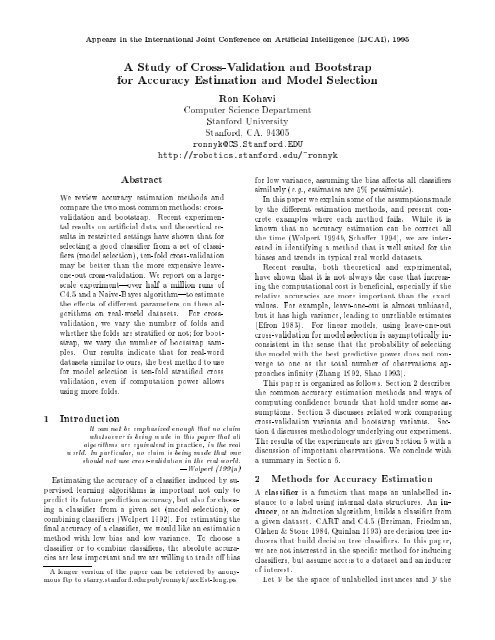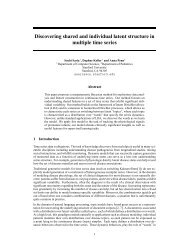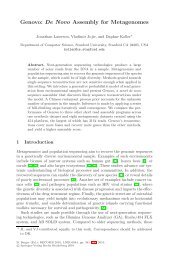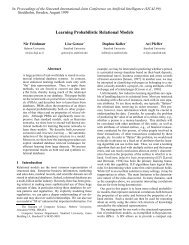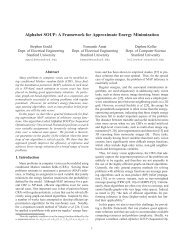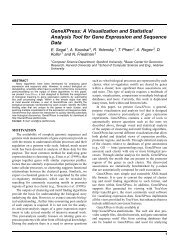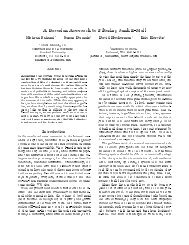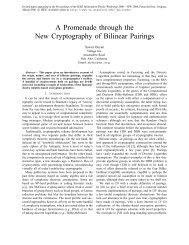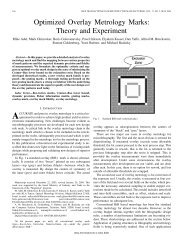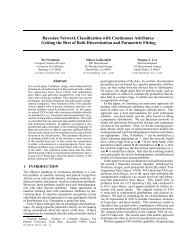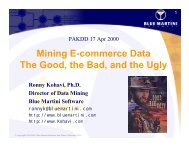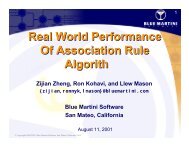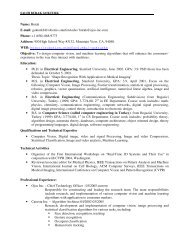A Study of Cross-Validation and Bootstrap for Accuracy Estimation ...
A Study of Cross-Validation and Bootstrap for Accuracy Estimation ...
A Study of Cross-Validation and Bootstrap for Accuracy Estimation ...
Create successful ePaper yourself
Turn your PDF publications into a flip-book with our unique Google optimized e-Paper software.
Appears in the International Joint Conference on Arti cial Intelligence (IJCAI), 1995<br />
A <strong>Study</strong> <strong>of</strong> <strong>Cross</strong>-<strong>Validation</strong> <strong>and</strong> <strong>Bootstrap</strong><br />
<strong>for</strong> <strong>Accuracy</strong> <strong>Estimation</strong> <strong>and</strong> Model Selection<br />
Abstract<br />
We review accuracy estimation methods <strong>and</strong><br />
compare the two most common methods: crossvalidation<br />
<strong>and</strong> bootstrap. Recent experimental<br />
results on arti cial data <strong>and</strong> theoretical results<br />
in restricted settings have shown that <strong>for</strong><br />
selecting a good classi er from a set <strong>of</strong> classiers<br />
(model selection), ten-fold cross-validation<br />
may be better than the more expensive leaveone-out<br />
cross-validation. We report on a largescale<br />
experiment|over half a million runs <strong>of</strong><br />
C4.5 <strong>and</strong> a Naive-Bayes algorithm|to estimate<br />
the e ects <strong>of</strong> di erent parameters on these algorithms<br />
on real-world datasets. For crossvalidation,<br />
we vary the number <strong>of</strong> folds <strong>and</strong><br />
whether the folds are strati ed or not <strong>for</strong> bootstrap,<br />
we vary the number <strong>of</strong> bootstrap samples.<br />
Our results indicate that <strong>for</strong> real-word<br />
datasets similar to ours, the best method to use<br />
<strong>for</strong> model selection is ten-fold strati ed cross<br />
validation, even if computation power allows<br />
using more folds.<br />
1 Introduction<br />
It can not be emphasized enough that no claim<br />
whatsoever is being made in this paper that all<br />
algorithms are equivalent in practice, in the real<br />
world. In particular, no claim is being made that one<br />
should not use cross-validation in the real world.<br />
|Wolpert (1994a)<br />
Estimating the accuracy <strong>of</strong> a classi er induced by supervised<br />
learning algorithms is important not only to<br />
predict its future prediction accuracy, but also <strong>for</strong> choosing<br />
a classi er from a given set (model selection), or<br />
combining classi ers (Wolpert 1992). For estimating the<br />
nal accuracy <strong>of</strong> a classi er, we would like an estimation<br />
method with low bias <strong>and</strong> low variance. To choose a<br />
classi er or to combine classi ers, the absolute accuracies<br />
are less important <strong>and</strong> we are willing to trade o bias<br />
A longer version <strong>of</strong> the paper can be retrieved by anonymous<br />
ftp to starry.stan<strong>for</strong>d.edu:pub/ronnyk/accEst-long.ps<br />
Ron Kohavi<br />
Computer Science Department<br />
Stan<strong>for</strong>d University<br />
Stan<strong>for</strong>d, CA. 94305<br />
ronnyk@CS.Stan<strong>for</strong>d.EDU<br />
http://robotics.stan<strong>for</strong>d.edu/~ronnyk<br />
<strong>for</strong> low variance, assuming the bias a ects all classi ers<br />
similarly (e.g., estimates are 5% pessimistic).<br />
In this paper we explain some <strong>of</strong> the assumptions made<br />
by the di erent estimation methods, <strong>and</strong> present concrete<br />
examples where each method fails. While it is<br />
known that no accuracy estimation can be correct all<br />
the time (Wolpert 1994b, Scha er 1994), we are interested<br />
in identifying a method that is well suited <strong>for</strong> the<br />
biases <strong>and</strong> trends in typical real world datasets.<br />
Recent results, both theoretical <strong>and</strong> experimental,<br />
have shown that it is not always the case that increasing<br />
the computational cost is bene cial, especially if the<br />
relative accuracies are more important than the exact<br />
values. For example, leave-one-out is almost unbiased,<br />
but it has high variance, leading to unreliable estimates<br />
(Efron 1983). For linear models, using leave-one-out<br />
cross-validation <strong>for</strong> model selection is asymptotically inconsistent<br />
in the sense that the probability <strong>of</strong> selecting<br />
the model with the best predictive power does not converge<br />
to one as the total number <strong>of</strong> observations approaches<br />
in nity (Zhang 1992, Shao 1993).<br />
This paper is organized as follows. Section 2 describes<br />
the common accuracy estimation methods <strong>and</strong> ways <strong>of</strong><br />
computing con dence bounds that hold under some assumptions.<br />
Section 3 discusses related work comparing<br />
cross-validation variants <strong>and</strong> bootstrap variants. Section<br />
4 discusses methodology underlying our experiment.<br />
The results <strong>of</strong> the experiments are given Section 5 with a<br />
discussion <strong>of</strong> important observations. We conclude with<br />
a summary in Section 6.<br />
2 Methods <strong>for</strong> <strong>Accuracy</strong> <strong>Estimation</strong><br />
A classi er is a function that maps an unlabelled instance<br />
to a label using internal data structures. An inducer,<br />
or an induction algorithm, builds a classi er from<br />
agiven dataset. CART <strong>and</strong> C4.5 (Breiman, Friedman,<br />
Olshen & Stone 1984, Quinlan 1993) are decision tree inducers<br />
that build decision tree classi ers. In this paper,<br />
we are not interested in the speci c method <strong>for</strong> inducing<br />
classi ers, but assume access to a dataset <strong>and</strong> an inducer<br />
<strong>of</strong> interest.<br />
Let V be the space <strong>of</strong> unlabelled instances <strong>and</strong> Y the
set <strong>of</strong> possible labels. Let X = V Ybe the space <strong>of</strong><br />
labelled instances <strong>and</strong> D = fx1x2:::xng be a dataset<br />
(possibly a multiset) consisting <strong>of</strong> n labelled instances,<br />
where xi = hvi 2Vyi 2Yi. A classi er C maps an unlabelled<br />
instance v 2V to a label y 2Y <strong>and</strong> an inducer I<br />
maps a given dataset D into a classi er C. The notation<br />
I(Dv) will denote the label assigned to an unlabelled instance<br />
v by the classi er built by inducer I on dataset D,<br />
i.e., I(Dv)=(I(D))(v). We assume that there exists a<br />
distribution on the set <strong>of</strong> labelled instances <strong>and</strong> that our<br />
dataset consists <strong>of</strong> i.i.d. (independently <strong>and</strong> identically<br />
distributed) instances. We consider equal misclassi cation<br />
costs using a 0/1 loss function, but the accuracy<br />
estimation methods can easily be extended to other loss<br />
functions.<br />
The accuracy <strong>of</strong> a classi er C is the probability <strong>of</strong><br />
correctly classifying a r<strong>and</strong>omly selected instance, i.e.,<br />
acc = Pr(C(v) = y) <strong>for</strong> a r<strong>and</strong>omly selected instance<br />
hv yi 2X, where the probability distribution over the<br />
instance space is the same as the distribution that was<br />
used to select instances <strong>for</strong> the inducer's training set.<br />
Given a nite dataset, we would like toestimate the future<br />
per<strong>for</strong>mance <strong>of</strong> a classi er induced by the given inducer<br />
<strong>and</strong> dataset. A single accuracy estimate is usually<br />
meaningless without a con dence interval thus we will<br />
consider how to approximate such aninterval when possible.<br />
In order to identify weaknesses, we also attempt<br />
to identify cases where the estimates fail.<br />
2.1 Holdout<br />
The holdout method, sometimes called test sample estimation,<br />
partitions the data into two mutually exclusive<br />
subsets called a training set <strong>and</strong> a test set, or holdout set.<br />
It is common to designate 2/3 <strong>of</strong> the data as the training<br />
set <strong>and</strong> the remaining 1/3 as the test set. The training<br />
set is given to the inducer, <strong>and</strong> the induced classi er is<br />
tested on the test set. Formally,letDh, the holdout set,<br />
be a subset <strong>of</strong> D <strong>of</strong> size h, <strong>and</strong> let Dt be DnDh. The<br />
holdout estimated accuracy is de ned as<br />
acch = 1<br />
h<br />
X<br />
hviyii2Dh<br />
(I(Dtvi)yi) (1)<br />
where (i j) =1if i = j <strong>and</strong> 0 otherwise. Assuming<br />
that the inducer's accuracy increases as more instances<br />
are seen, the holdout method is a pessimistic estimator<br />
because only a portion <strong>of</strong> the data is given to the inducer<br />
<strong>for</strong> training. The more instances we leave <strong>for</strong> the test set,<br />
the higher the bias <strong>of</strong> our estimate however, fewer test<br />
set instances means that the con dence interval <strong>for</strong> the<br />
accuracy will be wider as shown below.<br />
Each test instance can be viewed as a Bernoulli trial:<br />
correct or incorrect prediction. Let S be the number<br />
<strong>of</strong> correct classi cations on the test set, then S is distributed<br />
binomially (sum <strong>of</strong> Bernoulli trials). For reasonably<br />
large holdout sets, the distribution <strong>of</strong> S=h is approximately<br />
normal with mean acc (the true accuracy <strong>of</strong><br />
the classi er) <strong>and</strong> a variance <strong>of</strong> acc (1 ; acc)=h. Thus,<br />
by De Moivre-Laplace limit theorem, we have<br />
Pr<br />
(<br />
;z <<br />
acch ; acc<br />
p
k times each time t 2f1 2:::kg, it is trained on<br />
DnDt <strong>and</strong> tested on Dt. The cross-validation estimate<br />
<strong>of</strong> accuracy is the overall number <strong>of</strong> correct classi cations,<br />
divided by the number <strong>of</strong> instances in the dataset.<br />
Formally, let D (i) be the test set that includes instance<br />
xi = hviyii, then the cross-validation estimate <strong>of</strong> accuracy<br />
acccv = 1<br />
n<br />
X<br />
hviyii2D<br />
(I(DnD (i)vi)yi) : (4)<br />
The cross-validation estimate is a r<strong>and</strong>om number<br />
that depends on the division into folds. Complete<br />
cross-validation is the average <strong>of</strong> all ; m<br />
m=k possibilities<br />
<strong>for</strong> choosing m=k instances out <strong>of</strong> m, but it is<br />
usually too expensive. Except <strong>for</strong> leave-one-one (n-fold<br />
cross-validation), which is always complete, k-fold crossvalidation<br />
is estimating complete k-fold cross-validation<br />
using a single split <strong>of</strong> the data into the folds. Repeating<br />
cross-validation multiple times using di erent splits<br />
into folds provides a better Monte-Carlo estimate to the<br />
complete cross-validation at an added cost. In stratied<br />
cross-validation, the folds are strati ed so that<br />
they contain approximately the same proportions <strong>of</strong> labels<br />
as the original dataset.<br />
An inducer is stable <strong>for</strong> a given dataset <strong>and</strong> a set <strong>of</strong><br />
perturbations, if it induces classi ers that make the same<br />
predictions when it is given the perturbed datasets.<br />
Proposition 1 (Variance in k-fold CV)<br />
Given a dataset <strong>and</strong> an inducer. If the inducer is<br />
stable under the perturbations caused by deleting the<br />
instances <strong>for</strong> the folds in k-fold cross-validation, the<br />
cross-validation estimate will be unbiased <strong>and</strong> the variance<br />
<strong>of</strong> the estimated accuracy will be approximately<br />
acccv (1;acccv)=n, where n is the number <strong>of</strong> instances<br />
in the dataset.<br />
Pro<strong>of</strong>: Ifwe assume that the k classi ers produced make<br />
the same predictions, then the estimated accuracy has<br />
a binomial distribution with n trials <strong>and</strong> probability <strong>of</strong><br />
success equal to the accuracy <strong>of</strong> the classi er.<br />
For large enough n, a con dence interval maybecomputed<br />
using Equation 3 with h equal to n, the number<br />
<strong>of</strong> instances.<br />
In reality, a complex inducer is unlikelytobestable<br />
<strong>for</strong> large perturbations, unless it has reached its maximal<br />
learning capacity. We expect the perturbations induced<br />
by leave-one-out to be small <strong>and</strong> there<strong>for</strong>e the classi er<br />
should be very stable. As we increase the size <strong>of</strong> the<br />
perturbations, stability islesslikely to hold: we expect<br />
stability to hold more in 20-fold cross-validation than in<br />
10-fold cross-validation <strong>and</strong> both should be more stable<br />
than holdout <strong>of</strong> 1/3. The proposition does not apply<br />
to the resubstitution estimate because it requires the inducer<br />
to be stable when no instances are given in the<br />
dataset.<br />
The above proposition helps underst<strong>and</strong> one possible<br />
assumption that is made when using cross-validation: if<br />
an inducer is unstable <strong>for</strong> a particular dataset under a set<br />
<strong>of</strong> perturbations introduced by cross-validation, the accuracy<br />
estimate is likely to be unreliable. If the inducer<br />
is almost stable on a given dataset, we should expect<br />
a reliable estimate. The next corollary takes the idea<br />
slightly further <strong>and</strong> shows a result that we have observed<br />
empirically: there is almost no change in the variance <strong>of</strong><br />
the cross-validation estimate when the number <strong>of</strong> folds<br />
is varied.<br />
Corollary 2 (Variance in cross-validation)<br />
Given a dataset <strong>and</strong> an inducer. If the inducer is stable<br />
under the perturbations caused by deleting the test<br />
instances <strong>for</strong> the folds in k-fold cross-validation <strong>for</strong> various<br />
values <strong>of</strong> k, then the variance <strong>of</strong> the estimates will<br />
be the same.<br />
Pro<strong>of</strong>: Thevariance <strong>of</strong> k-fold cross-validation in Proposition<br />
1 does not depend on k.<br />
While some inducers are likely to be inherently more<br />
stable, the following example shows that one must also<br />
take into account the dataset <strong>and</strong> the actual perturbations.<br />
Example 1 (Failure <strong>of</strong> leave-one-out)<br />
Fisher's iris dataset contains 50 instances <strong>of</strong> each class,<br />
leading one to expect that a majority inducer should<br />
have accuracy about 33%. However, the combination <strong>of</strong><br />
this dataset with a majority inducer is unstable <strong>for</strong> the<br />
small perturbations per<strong>for</strong>med by leave-one-out. When<br />
an instance is deleted from the dataset, its label is a minority<br />
in the training set thus the majority inducer predicts<br />
one <strong>of</strong> the other two classes <strong>and</strong> always errs in classifying<br />
the test instance. The leave-one-out estimated<br />
accuracy <strong>for</strong> a majority inducer on the iris dataset is<br />
there<strong>for</strong>e 0%. Moreover, all folds have this estimated accuracy<br />
thus the st<strong>and</strong>ard deviation <strong>of</strong> the folds is again<br />
0%, giving the unjusti ed assurance that the estimate is<br />
stable.<br />
The example shows an inherent problem with crossvalidation<br />
that applies to more than just a majority inducer.<br />
In a no-in<strong>for</strong>mation dataset, where the label values<br />
are completely r<strong>and</strong>om, the best an induction algorithm<br />
can do is predict majority. Leave-one-out on such<br />
a dataset with 50% <strong>of</strong> the labels <strong>for</strong> each class <strong>and</strong> a<br />
majority inducer (the best possible inducer) would still<br />
predict 0% accuracy.<br />
2.3 <strong>Bootstrap</strong><br />
The bootstrap family was introduced by Efron <strong>and</strong> is<br />
fully described in Efron & Tibshirani (1993). Given a<br />
dataset <strong>of</strong> size n, abootstrap sample is created by<br />
sampling n instances uni<strong>for</strong>mly from the data (with replacement).<br />
Since the dataset is sampled with replacement,<br />
the probability <strong>of</strong>anygiven instance not being<br />
chosen after n samples is (1 ; 1=n) n<br />
e ;1 0:368 the
expected number <strong>of</strong> distinct instances from the original<br />
dataset appearing in the test set is thus 0:632n. The 0<br />
accuracy estimate is derived by using the bootstrap sample<br />
<strong>for</strong> training <strong>and</strong> the rest <strong>of</strong> the instances <strong>for</strong> testing.<br />
Given a number b, thenumber <strong>of</strong> bootstrap samples, let<br />
0i be the accuracy estimate <strong>for</strong> bootstrap sample i. The<br />
.632 bootstrap estimate is de ned as<br />
accboot = 1<br />
b<br />
bX<br />
i=1<br />
(0:632 0i + :368 accs) (5)<br />
where accs is the resubstitution accuracy estimate on<br />
the full dataset (i.e., the accuracy on the training set).<br />
The variance <strong>of</strong> the estimate can be determined by computing<br />
the variance <strong>of</strong> the estimates <strong>for</strong> the samples.<br />
The assumptions made by bootstrap are basically the<br />
same as that <strong>of</strong> cross-validation, i.e., stability <strong>of</strong> the algorithm<br />
on the dataset: the \bootstrap world" should<br />
closely approximate the real world. The .632 bootstrap<br />
fails to give the expected result when the classi er is a<br />
perfect memorizer (e.g., an unpruned decision tree or a<br />
one nearest neighbor classi er) <strong>and</strong> the dataset is completely<br />
r<strong>and</strong>om, say with two classes. The resubstitution<br />
accuracy is 100%, <strong>and</strong> the 0 accuracy is about 50%.<br />
Plugging these into the bootstrap <strong>for</strong>mula, one gets an<br />
estimated accuracy <strong>of</strong> about 68.4%, far from the real accuracy<br />
<strong>of</strong> 50%. <strong>Bootstrap</strong> can be shown to fail if we add<br />
a memorizer module to any given inducer <strong>and</strong> adjust its<br />
predictions. If the memorizer remembers the training set<br />
<strong>and</strong> makes the predictions when the test instance was a<br />
training instances, adjusting its predictions can make the<br />
resubstitution accuracy change from 0% to 100% <strong>and</strong> can<br />
thus bias the overall estimated accuracy in any direction<br />
we want.<br />
3 Related Work<br />
Some experimental studies comparing di erent accuracy<br />
estimation methods have been previously done, but most<br />
<strong>of</strong> them were on arti cial or small datasets. We now<br />
describe some <strong>of</strong> these e orts.<br />
Efron (1983) conducted ve sampling experiments <strong>and</strong><br />
compared leave-one-out cross-validation, several variants<br />
<strong>of</strong> bootstrap, <strong>and</strong> several other methods. The purpose<br />
<strong>of</strong> the experiments was to \investigate some related estimators,<br />
which seem to o er considerably improved estimation<br />
in small samples." The results indicate that<br />
leave-one-out cross-validation gives nearly unbiased estimates<br />
<strong>of</strong> the accuracy, but <strong>of</strong>ten with unacceptably high<br />
variability, particularly <strong>for</strong> small samples <strong>and</strong> that the<br />
.632 bootstrap per<strong>for</strong>med best.<br />
Breiman et al. (1984) conducted experiments using<br />
cross-validation <strong>for</strong> decision tree pruning. They chose<br />
ten-fold cross-validation <strong>for</strong> the CART program <strong>and</strong><br />
claimed it was satisfactory <strong>for</strong> choosing the correct tree.<br />
They claimed that \the di erence in the cross-validation<br />
estimates <strong>of</strong> the risks <strong>of</strong> two rules tends to be much more<br />
accurate than the two estimates themselves."<br />
Jain, Dubes & Chen (1987) compared the per<strong>for</strong>mance<br />
<strong>of</strong> the 0 bootstrap <strong>and</strong> leave-one-out cross-validation<br />
on nearest neighbor classi ers using arti cial data <strong>and</strong><br />
claimed that the con dence interval <strong>of</strong> the bootstrap<br />
estimator is smaller than that <strong>of</strong> leave-one-out. Weiss<br />
(1991) followed similar lines <strong>and</strong> compared strati ed<br />
cross-validation <strong>and</strong> two bootstrap methods with nearest<br />
neighbor classi ers. His results were that strati ed<br />
two-fold cross validation is relatively low variance <strong>and</strong><br />
superior to leave-one-out.<br />
Breiman & Spector (1992) conducted a feature subset<br />
selection experiments <strong>for</strong> regression, <strong>and</strong> compared<br />
leave-one-out cross-validation, k-fold cross-validation<br />
<strong>for</strong> various k, strati ed k-fold cross-validation, biascorrected<br />
bootstrap, <strong>and</strong> partial cross-validation (not<br />
discussed here). Tests were done on arti cial datasets<br />
with 60 <strong>and</strong> 160 instances. The behavior observed<br />
was: (1) the leave-one-out has low bias <strong>and</strong> RMS (root<br />
mean square) error, whereas two-fold <strong>and</strong> ve-fold crossvalidation<br />
have larger bias <strong>and</strong> RMS error only at models<br />
with many features (2) the pessimistic bias <strong>of</strong> ten-fold<br />
cross-validation at small samples was signi cantly reduced<br />
<strong>for</strong> the samples <strong>of</strong> size 160 (3) <strong>for</strong> model selection,<br />
ten-fold cross-validation is better than leave-one-out.<br />
Bailey & Elkan (1993) compared leave-one-out crossvalidation<br />
to .632 bootstrap using the FOIL inducer<br />
<strong>and</strong> four synthetic datasets involving Boolean concepts.<br />
They observed high variability <strong>and</strong> little bias in the<br />
leave-one-out estimates, <strong>and</strong> low variability but large<br />
bias in the .632 estimates.<br />
Weiss <strong>and</strong> Indurkyha (Weiss & Indurkhya 1994) conducted<br />
experiments on real-world data to determine the<br />
applicability <strong>of</strong> cross-validation to decision tree pruning.<br />
Their results were that <strong>for</strong> samples at least <strong>of</strong> size 200,<br />
using strati ed ten-fold cross-validation to choose the<br />
amount <strong>of</strong> pruning yields unbiased trees (with respect to<br />
their optimal size).<br />
4 Methodology<br />
In order to conduct a large-scale experiment we decided<br />
to use C4.5 <strong>and</strong> a Naive-Bayesian classi er. The C4.5<br />
algorithm (Quinlan 1993) is a descendent <strong>of</strong> ID3 that<br />
builds decision trees top-down. The Naive-Bayesian classi<br />
er (Langley, Iba & Thompson 1992) used was the one<br />
implemented in MLC++ (Kohavi, John, Long, Manley<br />
& P eger 1994) that uses the observed ratios <strong>for</strong> nominal<br />
features <strong>and</strong> assumes a Gaussian distribution <strong>for</strong> continuous<br />
features. The exact details are not crucial <strong>for</strong> this<br />
paper because we are interested in the behavior <strong>of</strong> the<br />
accuracy estimation methods more than the internals<br />
<strong>of</strong> the induction algorithms. The underlying hypothesis<br />
spaces|decision trees <strong>for</strong> C4.5 <strong>and</strong> summary statistics<br />
<strong>for</strong> Naive-Bayes|are di erent enough that we hope<br />
conclusions based on these two induction algorithms will<br />
apply to other induction algorithms.<br />
Because the target concept is unknown <strong>for</strong> real-world
concepts, we used the holdout method to estimate the<br />
quality <strong>of</strong> the cross-validation <strong>and</strong> bootstrap estimates.<br />
To choose a set <strong>of</strong> datasets, we looked at the learning<br />
curves <strong>for</strong> C4.5 <strong>and</strong> Naive-Bayes <strong>for</strong> most <strong>of</strong> the supervised<br />
classi cation datasets at the UC Irvine repository<br />
(Murphy & Aha 1995) that contained more than 500<br />
instances (about 25 such datasets). We felt that a minimum<br />
<strong>of</strong> 500 instances were required <strong>for</strong> testing. While<br />
the true accuracies <strong>of</strong> a real dataset cannot be computed<br />
because we do not know the target concept, we can estimate<br />
the true accuracies using the holdout method. The<br />
\true" accuracy estimates in Table 1 were computed by<br />
taking a r<strong>and</strong>om sample <strong>of</strong> the given size, computing the<br />
accuracy using the rest <strong>of</strong> the dataset as a test set, <strong>and</strong><br />
repeating 500 times.<br />
We chose six datasets from a wide variety <strong>of</strong>domains,<br />
such that the learning curve <strong>for</strong> both algorithms did<br />
not atten out too early, that is, be<strong>for</strong>e one hundred<br />
instances. We also added a no in<strong>for</strong>mation dataset,<br />
r<strong>and</strong>, with 20 Boolean features <strong>and</strong> a Boolean r<strong>and</strong>om<br />
label. On one dataset, vehicle, the generalization accuracy<br />
<strong>of</strong> the Naive-Bayes algorithm deteriorated by more<br />
than 4% as more instances were given. A similar phenomenon<br />
was observed on the shuttle dataset. Such<br />
a phenomenon was predicted by Scha er <strong>and</strong> Wolpert<br />
(Scha er 1994, Wolpert 1994b), but we were surprised<br />
that it was observed on two real-world datasets.<br />
To see how well an accuracy estimation method per<strong>for</strong>ms,<br />
we sampled instances from the dataset (uni<strong>for</strong>mly<br />
without replacement), <strong>and</strong> created a training set <strong>of</strong> the<br />
desired size. We then ran the induction algorithm on<br />
the training set <strong>and</strong> tested the classi er on the rest <strong>of</strong><br />
the instances in the dataset. This was repeated 50 times<br />
at points where the learning curve was sloping up. The<br />
same folds in cross-validation <strong>and</strong> the same samples in<br />
bootstrap were used <strong>for</strong> both algorithms compared.<br />
5 Results <strong>and</strong> Discussion<br />
We now show the experimental results <strong>and</strong> discuss their<br />
signi cance. We begin with a discussion <strong>of</strong> the bias in<br />
the estimation methods <strong>and</strong> follow with a discussion <strong>of</strong><br />
the variance. Due to lack<strong>of</strong>space,we omit some graphs<br />
<strong>for</strong> the Naive-Bayes algorithm when the behavior is approximately<br />
the same as that <strong>of</strong> C4.5.<br />
5.1 The Bias<br />
The bias <strong>of</strong> a method to estimate a parameter is dened<br />
as the expected value minus the estimated value.<br />
An unbiased estimation method is a method that has<br />
zero bias. Figure 1 shows the bias <strong>and</strong> variance <strong>of</strong> k-fold<br />
cross-validation on several datasets (the breast cancer<br />
dataset is not shown).<br />
The diagrams clearly show that k-fold cross-validation<br />
is pessimistically biased, especially <strong>for</strong> two <strong>and</strong> ve folds.<br />
For the learning curves that have a large derivative at<br />
the measurement point, the pessimism in k-fold cross-<br />
% acc<br />
75<br />
70<br />
65<br />
60<br />
55<br />
50<br />
45<br />
Soybean<br />
Vehicle<br />
% acc<br />
100<br />
98.5<br />
98<br />
97.5<br />
97<br />
96.5<br />
96<br />
R<strong>and</strong><br />
99.5<br />
Mushroom<br />
99<br />
Hypo<br />
Chess<br />
2 5 10 20 -5 -2 -1 folds<br />
2 5 10 20 -5 -2 -1 folds<br />
Figure 1: C4.5: The bias <strong>of</strong> cross-validation with varying<br />
folds. A negative k folds st<strong>and</strong>s <strong>for</strong> leave-k-out. Error<br />
bars are 95% con dence intervals <strong>for</strong> the mean. The gray<br />
regions indicate 95% con dence intervals <strong>for</strong> the true accuracies.<br />
Note the di erent ranges <strong>for</strong> the accuracy axis.<br />
validation <strong>for</strong> small k's is apparent. Most <strong>of</strong> the estimates<br />
are reasonably good at 10 folds <strong>and</strong> at 20 folds<br />
they are almost unbiased.<br />
Strati ed cross-validation (not shown) had similar behavior,<br />
except <strong>for</strong> lower pessimism. The estimated accuracy<br />
<strong>for</strong> soybean at 2-fold was 7% higher <strong>and</strong> at ve-fold,<br />
4.7% higher <strong>for</strong> vehicle at 2-fold, the accuracy was 2.8%<br />
higher <strong>and</strong> at ve-fold, 1.9% higher. Thus strati cation<br />
seems to be a less biased estimation method.<br />
Figure 2 shows the bias <strong>and</strong> variance <strong>for</strong> the .632 bootstrap<br />
accuracy estimation method. Although the .632<br />
bootstrap is almost unbiased <strong>for</strong> chess, hypothyroid, <strong>and</strong><br />
mushroom <strong>for</strong> both inducers, it is highly biased <strong>for</strong> soybean<br />
with C4.5, vehicle with both inducers, <strong>and</strong> r<strong>and</strong><br />
with both inducers. The bias with C4.5 <strong>and</strong> vehicle is<br />
9.8%.<br />
5.2 The Variance<br />
While a given method may have low bias, its per<strong>for</strong>mance<br />
(accuracy estimation in our case) may be poor<br />
duetohighvariance. In the experiments above, we have<br />
<strong>for</strong>med con dence intervals by using the st<strong>and</strong>ard deviation<br />
<strong>of</strong> the mean accuracy. We now switch to the<br />
st<strong>and</strong>ard deviation <strong>of</strong> the population, i.e., the expected<br />
st<strong>and</strong>ard deviation <strong>of</strong> a single accuracy estimation run.<br />
In practice, if one does a single cross-validation run, the<br />
expected accuracy will be the mean reported above, but<br />
the st<strong>and</strong>ard deviation will be higher by a factor <strong>of</strong> p 50,<br />
the number<strong>of</strong>runsweaveraged in the experiments.
Dataset no. <strong>of</strong> sample-size no. <strong>of</strong> duplicate C4.5 Naive-Bayes<br />
attr. / total size categories instances<br />
Breast cancer 10 50/699 2 8 91.37 0.10 94.22 0.10<br />
Chess 36 900/3196 2 0 98.19 0.03 86.80 0.07<br />
Hypothyroid 25 400/3163 2 77 98.52 0.03 97.63 0.02<br />
Mushroom 22 800/8124 2 0 99.36 0.02 94.54 0.03<br />
Soybean large 35 100/683 19 52 70.49 0.22 79.76 0.14<br />
Vehicle 18 100/846 4 0 60.11 0.16 46.80 0.16<br />
R<strong>and</strong> 20 100/3000 2 9 49.96 0.04 49.90 0.04<br />
Table 1: True accuracy estimates <strong>for</strong> the datasets using C4.5 <strong>and</strong> Naive-Bayes classi ers at the chosen sample sizes.<br />
% acc<br />
75<br />
70 Soybean<br />
65<br />
60 Vehicle<br />
55<br />
50<br />
45<br />
R<strong>and</strong><br />
% acc<br />
100<br />
99.5<br />
Mushroom<br />
99<br />
98.5<br />
98<br />
97.5<br />
97<br />
96.5<br />
96<br />
Hypo<br />
Chess<br />
1 2 5 10 20 50 100<br />
Estimated<br />
Soybean<br />
Vehicle<br />
R<strong>and</strong><br />
samples<br />
1 2 5 10 20 50 100 samples<br />
Figure 2: C4.5: The bias <strong>of</strong> bootstrap with varying samples.<br />
Estimates are good <strong>for</strong> mushroom, hypothyroid,<br />
<strong>and</strong> chess, but are extremely biased (optimistically) <strong>for</strong><br />
vehicle <strong>and</strong> r<strong>and</strong>, <strong>and</strong> somewhat biased <strong>for</strong> soybean.<br />
In what follows, all gures <strong>for</strong> st<strong>and</strong>ard deviation will<br />
be drawn with the same range <strong>for</strong> the st<strong>and</strong>ard deviation:<br />
0 to 7.5%. Figure 3 shows the st<strong>and</strong>ard deviations<br />
<strong>for</strong> C4.5 <strong>and</strong> Naive Bayes using varying number<br />
<strong>of</strong> folds <strong>for</strong> cross-validation. The results <strong>for</strong> strati ed<br />
cross-validation were similar with slightly lower variance.<br />
Figure 4 shows the same in<strong>for</strong>mation <strong>for</strong> .632 bootstrap.<br />
<strong>Cross</strong>-validation has high variance at 2-folds on both<br />
C4.5 <strong>and</strong> Naive-Bayes. On C4.5, there is high variance<br />
at the high-ends too|at leave-one-out <strong>and</strong> leave-twoout|<strong>for</strong><br />
three les out <strong>of</strong> the seven datasets. Strati cation<br />
reduces the variance slightly, <strong>and</strong> thus seems to be<br />
uni<strong>for</strong>mly better than cross-validation, both <strong>for</strong> bias <strong>and</strong><br />
variance.<br />
std dev<br />
7<br />
6<br />
5<br />
4<br />
3<br />
2<br />
1<br />
0<br />
std dev<br />
7<br />
6<br />
5<br />
4<br />
3<br />
2<br />
1<br />
0<br />
Vehicle<br />
Soybean<br />
R<strong>and</strong><br />
Breast<br />
Hypo<br />
Chess<br />
Mushroom<br />
Vehicle<br />
R<strong>and</strong><br />
Soybean<br />
Breast<br />
Chess<br />
Hypo<br />
Mushroom<br />
C4.5<br />
2 5 10 20 -5 -2 -1 folds<br />
Naive-Bayes<br />
2 5 10 20 -5 -2 -1 folds<br />
Figure 3: <strong>Cross</strong>-validation: st<strong>and</strong>ard deviation <strong>of</strong> accuracy<br />
(population). Di erent linestyles are used to help<br />
di erentiate between curves.<br />
6 Summary<br />
We reviewed common accuracy estimation methods including<br />
holdout, cross-validation, <strong>and</strong> bootstrap, <strong>and</strong><br />
showed examples where each one fails to produce a good<br />
estimate. We have compared the latter two approaches<br />
on a variety <strong>of</strong> real-world datasets with di ering characteristics.<br />
Proposition 1 shows that if the induction algorithm<br />
is stable <strong>for</strong> a given dataset, the variance <strong>of</strong> the crossvalidation<br />
estimates should be approximately the same,<br />
independent <strong>of</strong> the number <strong>of</strong> folds. Although the induction<br />
algorithms are not stable, they are approximately<br />
stable. k-fold cross-validation with moderate k values<br />
(10-20) reduces the variance while increasing the bias.<br />
As k decreases (2-5) <strong>and</strong> the sample sizes get smaller,<br />
there is variance due to the instability <strong>of</strong> the training
std dev<br />
7<br />
6<br />
5<br />
4<br />
3<br />
Soybean<br />
R<strong>and</strong><br />
Vehicle<br />
Breast<br />
C4.5<br />
1 2 5 10 20 50 100 samples<br />
2<br />
1 Hypo<br />
Mushroom<br />
Chess<br />
0<br />
Figure 4: .632 <strong>Bootstrap</strong>: st<strong>and</strong>ard deviation in accuracy<br />
(population).<br />
sets themselves, leading to an increase in variance. This<br />
is most apparent <strong>for</strong> datasets with many categories, such<br />
as soybean. In these situations, strati cation seems to<br />
help, but repeated runs may be a better approach.<br />
Our results indicate that strati cation is generally a<br />
better scheme, both in terms <strong>of</strong> bias <strong>and</strong> variance, when<br />
compared to regular cross-validation. <strong>Bootstrap</strong> has low<br />
variance, but extremely large bias on some problems. We<br />
recommend using strati ed ten-fold cross-validation <strong>for</strong><br />
model selection.<br />
Acknowledgments We thank David Wolpert <strong>for</strong> a<br />
thorough reading <strong>of</strong> this paper <strong>and</strong> manyinteresting discussions.<br />
We thank Wray Buntine, Tom Byl<strong>and</strong>er, Brad<br />
Efron, Jerry Friedman, Rob Holte, George John, Pat<br />
Langley, Rob Tibshirani, <strong>and</strong> Sholom Weiss <strong>for</strong> their<br />
helpful comments <strong>and</strong> suggestions. Dan Sommer eld<br />
implemented the bootstrap method in MLC++. All experiments<br />
were conducted using MLC++, partly partly<br />
funded by ONR grant N00014-94-1-0448 <strong>and</strong> NSF grants<br />
IRI-9116399 <strong>and</strong> IRI-9411306.<br />
References<br />
Bailey, T.L.&Elkan, C. (1993), Estimating the accuracy<br />
<strong>of</strong> learned concepts, in \Proceedings <strong>of</strong> International<br />
Joint Conference on Arti cial Intelligence",<br />
Morgan Kaufmann Publishers, pp. 895{900.<br />
Breiman, L. & Spector, P. (1992), \Submodel selection<br />
<strong>and</strong> evaluation in regression. the x-r<strong>and</strong>om case",<br />
International Statistical Review 60(3), 291{319.<br />
Breiman, L., Friedman, J. H., Olshen, R. A. & Stone,<br />
C. J. (1984), Classi cation <strong>and</strong> Regression Trees,<br />
Wadsworth International Group.<br />
Efron, B. (1983), \Estimating the error rate <strong>of</strong> a prediction<br />
rule: improvement on cross-validation",<br />
Journal <strong>of</strong> the American Statistical Association<br />
78(382), 316{330.<br />
Efron, B. & Tibshirani, R. (1993), An introduction to<br />
the bootstrap, Chapman & Hall.<br />
Jain, A. K., Dubes, R. C. & Chen, C. (1987), \<strong>Bootstrap</strong><br />
techniques <strong>for</strong> error estimation", IEEE transactions<br />
on pattern analysis <strong>and</strong> machine intelligence<br />
PAMI-9(5), 628{633.<br />
Kohavi, R., John, G., Long, R., Manley, D. &<br />
P eger, K. (1994), MLC++: A machine learning<br />
library in C++, in \Tools with Arti cial<br />
Intelligence", IEEE Computer Society Press,<br />
pp. 740{743. Available by anonymous ftp from:<br />
starry.Stan<strong>for</strong>d.EDU:pub/ronnyk/mlc/toolsmlc.ps.<br />
Langley, P., Iba, W. & Thompson, K. (1992), An analysis<br />
<strong>of</strong> bayesian classi ers, in \Proceedings <strong>of</strong> the<br />
tenth national conference on arti cial intelligence",<br />
AAAI Press <strong>and</strong> MIT Press, pp. 223{228.<br />
Murphy, P. M. & Aha, D. W. (1995), UCI<br />
repository <strong>of</strong> machine learning databases,<br />
http://www.ics.uci.edu/~mlearn/MLRepository.html.<br />
Quinlan, J. R. (1993), C4.5: Programs <strong>for</strong> Machine<br />
Learning, Morgan Kaufmann, Los Altos, Cali<strong>for</strong>nia.<br />
Scha er, C. (1994), A conservation law <strong>for</strong> generalization<br />
per<strong>for</strong>mance, in \Machine Learning: Proceedings<br />
<strong>of</strong> the Eleventh International Conference", Morgan<br />
Kaufmann, pp. 259{265.<br />
Shao, J. (1993), \Linear model selection via crossvalidation",<br />
Journal <strong>of</strong> the American Statistical Association<br />
88(422), 486{494.<br />
Weiss, S. M. (1991), \Small sample error rate estimation<br />
<strong>for</strong> k-nearest neighbor classi ers", IEEE Transactions<br />
on Pattern Analysis <strong>and</strong> Machine Intelligence<br />
13(3), 285{289.<br />
Weiss, S. M. & Indurkhya, N. (1994), Decision tree<br />
pruning : Biased or optimal, in \Proceedings <strong>of</strong><br />
the twelfth national conference on arti cial intelligence",<br />
AAAI Press <strong>and</strong> MIT Press, pp. 626{632.<br />
Wolpert, D. H. (1992), \Stacked generalization", Neural<br />
Networks 5, 241{259.<br />
Wolpert, D. H. (1994a), O -training set error <strong>and</strong> a priori<br />
distinctions between learning algorithms, Technical<br />
Report SFI TR 94-12-123, The Sante Fe Institute.<br />
Wolpert, D. H. (1994b), The relationship between PAC,<br />
the statistical physics framework, the Bayesian<br />
framework, <strong>and</strong> the VC framework, Technical report,<br />
The Santa Fe Institute, Santa Fe, NM.<br />
Zhang, P. (1992), \On the distributional properties <strong>of</strong><br />
model selection criteria", Journal <strong>of</strong> the American<br />
Statistical Association 87(419), 732{737.


